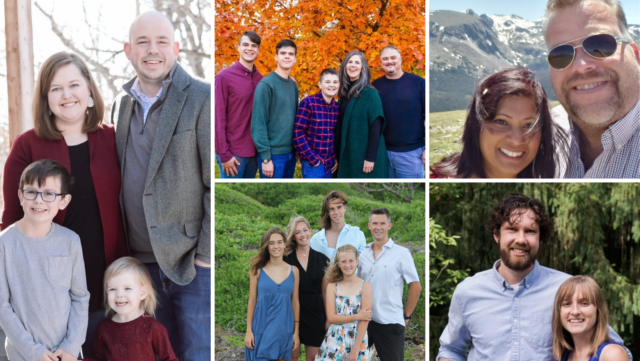Jim Pool interviews Ken Wilson, Ann Arbor (MI) Vineyard
“I’m building the kind of church that I would want to attend.” This is Ken Wilson’s simple explanation for what characterizes the Ann Arbor Vineyard, a church sitting in the heart of one of the Midwest’s cultural centers (and home to one of the nation’s top public universities, the University of Michigan).
The church’s sense of identification with the city is clear in even the smallest of ways. The headquarters of the Ann Arbor Vineyard—a nondescript building that formerly housed a local roller rink and civic theater—still has the old roller-rink logo along one of its hallways: “Ann Arbor Skate Club and Coaching Staff.” It acts as a constant reminder that the church isn’t some all-purpose franchise that might just as easily function anywhere else; rather, it’s a community of people called to a particular place, a certain locale, in which they are learning to embody Jesus together.
And Jesus, it appears, is keeping busy. The church serves a monthly gourmet meal to 100 single moms and kids, while helping them with their homes, their cars, and their groceries in the weeks in-between. They’ve formed a long-term, cross-racial partnership with a church in a neighboring town. And alongside developing such outreach, many in the church have been working to develop their inward life, too—learning to pray the liturgical hours, for example, as well as engaging more deeply with the disciplines of silence and solitude. (Ken will begin training as a spiritual director at a nearby Jesuit retreat center this fall.) Not surprisingly, as a church connected to the rhythms of academic life in a university town, roughly half of the church’s visitors are unchurched and between the ages of 18 and 34.
The Ann Arbor Vineyard has its roots in the Catholic-Ecumenical Community movement. The small congregation left that group in 1990 and, under Ken’s leadership, adopted into the Vineyard in 1994. Since then the church has grown substantially, with a weekly attendance of nearly 700, and has planted a church of 150 in Milan, a nearby town. (A second church plant is about to be launched, and a third is already in the planning stages.) Ken also co-authored, with Columbus Vineyard pastor Rich Nathan, the book Empowered Evangelicals (Vine Books, 1995).
Recently Ken talked with us about the church and the vision they’ve had for the city. Upon entering the former roller rink, the bustling noises from metro Ann Arbor fade and one surveys a colorful, artsy lounge—radically different from the building’s subdued, humble exterior—that would be the envy of any coffee shop. The church foyer is an inviting gathering space, with comfy couches, café tables, and walls filled with funky art from a local artist who attends the church. Ken’s office—right at the front—announces his availability, and his manner is relaxed and affable while talking about what it looks like to be a church living out a thoughtful, engaged life of faith.
What sort of things led to the Ann Arbor Vineyard becoming the kind of church that it is today?
A lot of it is about what John Wimber used to talk about: putting together a church that you yourself would want to go to! The Ann Arbor Vineyard is that kind of church for me. When you pass the age of fifty, you begin to realize you are pretty much stuck with who you are, and you are done trying other models. So this church reflects who I am: a child of parents who were part of the Young Socialist Workers League in the late thirties, with a dad who belonged to the NAACP right before the war. I have always had latent liberal leanings politically!
How important is that kind of orientation to leading a church in Ann Arbor?
The typical Ann Arborite values education, leans left politically, and is environmentally concerned. Michigan has long been something of a hotbed of radicalism, actually. When I went to school here, we had the Black Action Movement and were known for having teach-ins on the college campus. Tom Hayden and the Students for a Democratic Society started its early years here. John F. Kennedy did hes Peace Corps speech on the steps of the Michigan Union.
But I think that large segments of Ann Arbor haven’t been reached by evangelicals at all. So much of the straight “evangelical culture” is a turn-off for an Ann Arborite—even those things we think of as “wildly contemporary”. People around here see “contemporary worship” with a rock ‘n’ roll band and associate it with Benny Hinn and the stuff on cable TV. There is a lot of cynicism about standard charismatic forms of worship in Ann Arbor—more than there is in, say, Milan, where we planted a church only a few miles away. There, Vineyard worship is cool and different.
Ann Arbor also has a strong social conscience, although liberalism here has reached a certain point of bankruptcy and reassessment. But that makes it a great time for us as a church to come in and play some different notes.
You have mentioned in the past that humility is the key to reaching the heart of Ann Arbor.
We’ve always felt that a downside of Ann Arbor’s strengths is a certain arrogance. So as a church, we are pretty conscious about trying to come in low, under the radar screen. There’s an “otherness” to God’s kingdom that Ann Arborites, when they encounter it, sniff out as different and are drawn to it. But primarily we try to cultivate humility for the sake of our own souls. If you are going to be a Christ-follower in Ann Arbor—especially if you are going to be reaching out—there is a danger of falling into arrogance and intellectualism.
Today’s evangelical mindset seems to play to a certain confidence—coming out of the “Christian ghetto” and assertively “taking our place” in the wider culture. How does an attitude of humility fit with that?
Sometimes, unfortunately, it’s contrary to it. For instance, Ann Arbor had a take-over by conservatives on the school board years ago. They mobilized people on the grass-roots level and took control of the school board. Most Ann Arborites saw it as a power grab—and it was. So is that how the followers of Jesus should be viewed in Ann Arbor: if they can make a grab for power, they will do it, and if they can organize better than their opponents, they will? I think it’s really important for the church in Ann Arbor to not meet those expectations.
Is it possible to model a different way of approaching things among churches?
Evangelicals around here are more known for what they oppose (like abortion and gay marriage) than what they’re for. But if the evangelical churches in this city got together and focused instead on creating a ministry to single moms, or black-white partnerships, I think it would change the perception of the Church in Ann Arbor in very short order. So I’m frustrated with the limited issues evangelicals and charismatics get concerned with.
Evangelicals in a secular town have a great temptation to circle the wagons because secularism is sharp and aggressive sometimes. But truthfully, we can afford to be gracious. We can afford to be merciful. We can critique secular culture with sharp and cogent arguments rather than just attack it. I like Ann Arbor, liberalism and all, but I’ve lived here thirty years, and that’s been enough time to cycle through periods of being irritated by its secularism and periods of enjoying its quirkiness. A problem with evangelicals is that we often don’t stay in one place long enough to work out a relationship with that place—enabling us to see what’s best in it, affirm what’s good in it, yet also have a platform for critiquing its deficits.
I have a feeling that going in the direction of mercy, grace, and tangible investment in the city where you live is not only refreshing for the community looking at the church, but it is also refreshing for second-generation evangelicals and others who are chafing at some of the cultural expressions of evangelicalism. They are tired of the “Christ against culture” church environment. They’d like to see what a “Christ transforming culture” environment might be like. We don’t have to change the church culture that much to do it. Nor do we have to give up on key moral issues. But we don’t have to let a certain, narrow range of issues become “touchstone”, up-front, welcome-defining issues, either.
How does alertness to a wider range of issues affect the way your church community looks?
I think it’s possible for the Holy Spirit to do stuff that has been defined by others as impossible. The head of our men’s ministry is an activist in the Democratic Party. Some evangelicals are going to have to make their peace with the concept that that’s possible, or that perhaps it’s not a sin to have voted for Bill Clinton!
Given the way Christianity is often portrayed, it’s hard for those in Ann Arbor to become Christians. It’s harder still if they are told that they have to buy into “young earth” creationism, for example, or vote straight Republican. I used to give talks critiquing secularism. In thirty years I never had one person come up to me afterward and say, “You just nailed it, Ken. You’re right, I’m wrong.” That stuff is only effective with already-evangelical kids nervously headed off to secular universities.
You’ve talked in other contexts about “the unique challenge of winning secular people to the inspiration of Scripture.” How would you describe that challenge?
Our standard evangelical response to the challenge of winning secular people is to get your doctrine of the Bible clear: that it’s infallible, inerrant, etc. But that doesn’t mean anything to the person outside the Christian community! Their concern is, “Is there any power in this? Will this help me? Can I encounter God in the Bible?” This may be one of the places where the differentiations people have made between modernists and post-modernists are especially valid. In the older model, if you could establish that the Bible is the Word of God, people would be willing to build on that and go from there. But of course, that’s not really how most people come to faith. I came to faith not by first believing in the inerrancy of the Bible but by having a need, and having a friend who was following Jesus.
Along the way we need to be sensitive to the roadblocks that might get thrown up for people. Take evolution as an example. If Christians make “young-earth creationism” a boundary marker for orthodox Christian faith, they are placing an enormous barrier to the gospel for scientists and other thoughtful people seeking Christ. I’ve found that simply by letting people know that I personally don’t adopt a young-earth creationist perspective, and that Christians have many views about how God created the universe, and that there are various ways to read the first few chapters of Genesis, this barrier to faith is lifted. I also point out that this is not an issue that Christians in places other than North America are much vexed over. I’m always looking for ways for people to encounter God. So just making assertions about the authority of the Bible doesn’t do much for secular people these days. Expressing love for it, talking about how it has affected your life, how it’s helped you encounter God—that’s different.
One of the big things you talk about at your church is “Jesus-brand spirituality.” How did that description come about?
The one question that we were having trouble adequately answering in our “Introduction to the Vineyard” class at the church was, “How do I describe Vineyard to my friends?” We sat down and tried to brainstorm ways to do that. Some people suggested “small groups,” or “contemporary worship”. But those are church words. Just recently someone I knew was at Borders Bookstore, ran into an unchurched friend, and they started talking about church. She described how we did things as “Jesus-brand spirituality”—and ever since we’ve found that to be a very helpful description. The word “spirituality” is one that people understand in Ann Arbor. But “Jesus-brand” is specific, not generic, and implies a certain content. So it actually says something about us that an unchurched person can understand.
An Ann Arborite would recognize what this is.
The charismatic movement here has lost its voice in the culture because of some of the cultural baggage. In the sixties and early seventies—when the charismatic movement was strong here among the Baby Boomers—charismatic was cool, expressive, fitting right in with the culture. But in today’s culture, charismatic behavior gets stereotyped as part of conservative Christianity. Talking about Jesus, on the other hand, is a different matter.
We talk about being a church that is both active and contemplative. Active means simply “doing the stuff”—praying for the sick, feeding the poor, pursuing social justice. We don’t frame it as “Word and Spirit”. You could do it that way. But John Wimber’s approach is rooted in Quakerism, and his big contributions to Holy Spirit ministry were all about “dialing down”, being quiet, silence, listening. That frames the contemplative side in words the Ann Arborite can understand and appreciate.
And the active side relates to the kingdom agenda that Jesus talked about.
Outward-focused, active in the community, bringing the Gospel out beyond the church walls, praying for the sick, serving the poor. We try to keep the balance, working at the same time to develop the inner lives of believers, equipping them with the skills they need to recharge their batteries spiritually so they don’t burn out. I personally think that stillness, silence and solitude are the spiritual disciplines for our time. That completely resonates with secular people. In other eras, of course, silence and solitude were built-in. But today we have TV and the computer. Those disciplines, however, haven’t been much of an emphasis in the charismatic world.
What are you doing to encourage that contemplative life in your church?
Mainly we are continuing to stir the pot on the subject. A running joke from the pulpit is when I say, “Have I mentioned The Divine Hours?” I run six-week start-up groups for people who want to get started trying out this discipline. It is a Divine Hours Support Group! We spend 25 minutes before the Sunday morning service, with six or eight people. I discuss what praying the Offices are all about, how to get it started, how to think about it, and then we model it for six weeks. I’ve prayed the hours daily for the past two years. Some small group leaders have picked it up and it’s starting to filter out through the church community. It won’t work for everybody, of course. When I teach these groups I talk a little bit about silence and stillness—what’s the value of it, how to incorporate it. I would love to get morning prayers going here seven days a week.
As in, “Show up, we’ll be here at the church each morning praying, regardless”?
Right. I’m working on it, modeling it, talking about it, getting other leaders doing it, putting some of the mentoring online on our website. As people come through Alpha and want to pursue Jesus, they begin asking how to get started praying, and this is a good tool. Everyone on staff knows that if you want to help people get started praying, the Divine Hours can help give it a structure.
We’re trying to pray more together as a church. But it’s hard. Just praying the Lord’s Prayer together on a Sunday morning is a minefield! You have ex-Catholics who are used to praying through it really fast; you have evangelicals who are suspicious of praying anything at all together; plus, people have learned four or five different versions. Just getting the Power Point person to put the one you want to use up on the screen is an adventure.
I would imagine that the strength of Jesus-brand spirituality is that it really authenticates the Gospel within the secular community of Ann Arbor.
It does. We started a compassion ministry down in Milan, and that was a totally authenticating structure for the Gospel for everybody—not just for Ann Arborites, but for us, too. It became one of the main things people in the community would tell other people about our church. What I like is that we have something to contribute that secular liberals haven’t actually accomplished (which exposes the crisis in liberalism). The church has the option of giving relationship to the poor, of giving services to them in the context of real and ongoing relationships—rather than just throwing resources at the poor as the agency model does. We are very conscious about not having an “agency” feel to our compassion ministry. Our compassion ministry isn’t about just giving out goodies; it’s about creating a community.
So you are inviting the poor into relationship as the central piece—with food and clothing as part of that—because the motivation then becomes simply wanting to make sure your friends are provided for?
Relationship is the currency of the kingdom, and you can only grow a ministry built on relationship where people know and trust each other.
How does this concern for community work itself out in your ministry to the poor?
Once a month we have a dinner for a hundred single moms and their children. The moms have a dedicated team that puts on a dinner just for them away from their kids, so they can have adult conversation. That develops relationships like nothing else. It started small, as a small group thing, really, and then we just added services to that ministry gradually—a car care component, a home repair component, a grocery give-away, Christmas gifts from the church. When you walk into the room on those dinner nights, you are walking into a group of people who know each other and love each other. Groceries are set out right at the end, so it’s the last thing, not the central thing. The meal keeps getting more creative; now they have chefs and wait-staff, and nice table-settings.
We could grow it faster. If we told the Ann Arbor News what’s going on, we could get an article about it instantly; but we don’t want to because the point is relationship, not numbers. The single moms are meeting each other and getting support from each other. They are meeting others who are not single moms through the team. These are a group of people who hesitate to go to a church, especially a standard church that is billed as a “family worship center”. We’ve had single moms who came from fundamentalist churches, women who got pregnant as teenagers and were forced to stand up in front of the congregation and apologize to the whole church, who were told they weren’t welcome anymore. So they feel like refugees. I think if you say you are a church that cares practically and relationally for single moms, that tells people a lot about your church.
What would you say to church planters who want to bring this sort of approach to their fledgling church?
I would say that you cannot do this unless you have a heart for it, and you can’t fake having that heart. Some people can make the transition and some people can’t. If you can’t, don’t try. There’s a guy who moved here from Texas—a big NRA supporter and former Green Beret. He came into our church and about went into shock. But because he has such a big heart for people, he could accept what we were doing and see why we were doing it.
To a young church planter, I’d say, “Take your time. Work from the inside out. Press it out in your own personal life in a way that’s workable for you. Think, ‘How can this build relationships? How can the way we do this lead to building relationships and not just getting the task done?’” You can only have a certain number of core convictions; let community be one of them.
There are no easy answers. The wider culture is impoverished in terms of community, and we often experience that poverty ourselves. So it isn’t just a matter of conviction, but also lifestyle, and how we choose to live our life.




